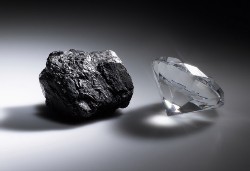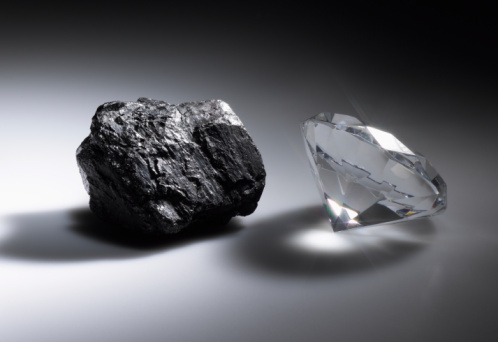Diamonds Aren’t Forever
A flash of light can temporarily alter the structure of graphite. A team reporting in the 15 August Physical Review Letters found that–for a brief moment at least–exposure to light changes the chemical bonding in graphite to a form reminiscent of diamond. Future improvements may allow a complete conversion to diamond. This research could lead to new nanoscale techniques wherein a laser builds structures of diamond and graphite on a surface of a carbon thin film.
While chunks of industrial diamonds can be made through chemical reactions, there is currently no way to convert the graphite form of carbon to the diamond structure in thin films. But imagine if a focused laser beam could do such a conversion. The beam could “write” a nanoscale electronic circuit in a thin graphite layer, exploiting the strength and insulating properties of diamond in some areas and the semiconductive nature of graphite in other areas, says David Tománek of Michigan State University in East Lansing.
A team led by Tománek and Chong-Yu Ruan, also of Michigan State, has taken a step toward this dream by showing a specific structural change in graphite resulting from laser light. The team illuminated a graphite target with 45-femtosecond pulses from a near-infrared laser. Synchronized with the light pulses were short bursts of an electron beam that allowed the team to probe the carbon atoms’ positions using the technique of electron diffraction.
Atoms of graphite normally bond within two-dimensional layers that are 0.34 nanometers apart, with only weak bonds between layers. But the team saw a large fraction of the atoms in the top few layers briefly form into a layer just 0.19 nanometers from its neighbor. Combining this observation with other diffraction analyses and computer simulations, they concluded that within 14 picoseconds following the laser pulse, many atoms form inter-layer bonds similar in some ways to those in diamond. 30 picoseconds later, these bonds have disappeared.
Tománek hopes ultimately to push this transient state into the full diamond structure, rather than letting it fall back to graphite. But the work suggests that the graphite in any pencil tip exposed to sunlight for a long time may contain tiny regions that snap to the diamond structure after being excited to the intermediate state.
Tomas Weller of the ISIS Neutron Facility in England has shown that the right kind of laser pulse can convert industrial diamonds into graphite, and he, too, hopes to someday make nanostructures using light. Regarding the Michigan State team’s work, Weller is excited by the answers it brings to the emerging field of photoexcitation in solids. “It kind of draws together a number of different questions that have been bubbling along in these fields, and it links them together.” he says.
–Mike Wofsey





